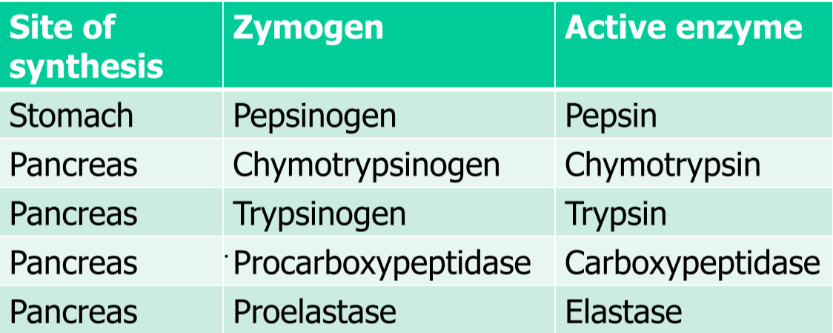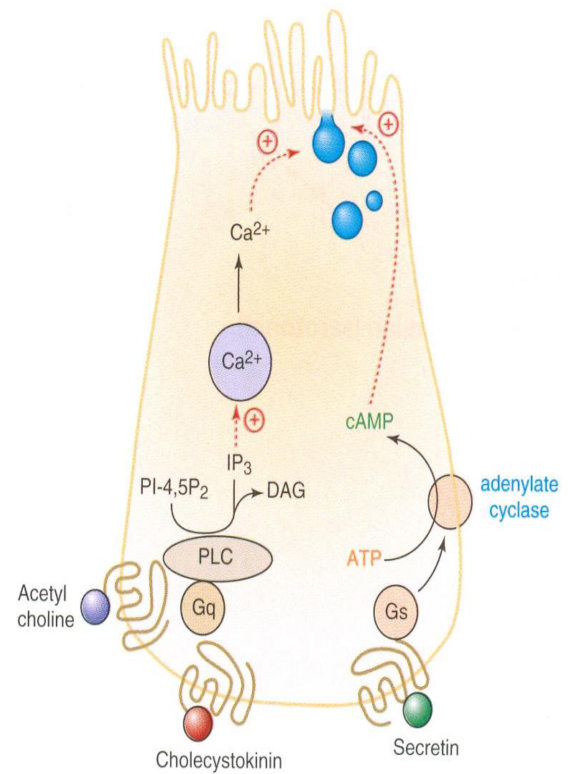Table of Contents
Page created on March 7, 2018. Last updated on December 18, 2024 at 16:55
Summary
- Energy in the body is used for biosynthesis, maintaining gradients, heat production and physical work
- The basal metabolic rate is influenced by body surface, age, gender and exercise
- The macronutrients are water, proteins, carbohydrates, lipids and ballast substances
- The micronutrients are vitamins, minerals and trace elements
- Digestion starts with amylase, released from the salivary glands in the mouth. It hydrolyses starch
- Digestion, and the enzymes and chemical associated with it, is activated by the parasympathetic nervous system, by acetylcholine, gastrin and secretin
- Each body fluid, like gastric and pancreatic juice, is based on serum
- HCl in the stomach is produced by the H+/K+ ATPase antiporter (the protein pump)
- Heartburn can be treated by antacids, histamine antagonists, and protein pump inhibitors
Macronutrients
Water is the end-product of energy production in the body, which means there is no way for the body to extract energy from it. It therefore contains 0 calories (kcal) per gram. It is still essential however, obviously).
Proteins contain relatively low energy, because they contain some highly oxidized groups like COO–. They contain about 4 kcal/g.
Carbohydrates contain many oxygens as well, which means that it’s also relatively highly oxidized and therefore low energy. They also contain about 4 kcal/g.
Lipids contain the highest amount of energy, because they’re the most reduced. They contain 9 kcal/g.
Digestion

Digestion begins in the mouth, where the salivary glands produce α-amylase, which breaks down starch into oligosaccharides and sugars. When the food gets into the stomach, the amylase is deactivated by the low pH.
Digestion is stimulated by the parasympathetic nervous system, the part of the nervous system that’s active when the body is at rest. Acetylcholine is the main parasympathetic neurotransmitter, and as seen in the table above stimulates secretion of most of the compounds needed for digestion. Gastrin is released in response to food intake, while secretin is released in response to a low pH in the beginning of the small intestines, which occurs when the highly acidic gastric acid is released together with food into the intestines.


For the parietal cells in the stomach to secrete HCl into the lumen, multiple transporters are needed, as seen in the picture above. The most well-known is the H+/K+ ATPase antiporter, the proton pump. It’s the transporter to the left in the drawing. It pumps protons (H+-ions) into the lumen, while transporting K+ from the lumen into the cell. Inside the cell, carbonic anhydrase catalyses CO2 + H2O -> HCO3– + H+, which is the source of the hydrogen ions that are pumped into the lumen. The bicarbonate is pumped out of the cell into the blood by a bicarbonate/Cl– antiporter, which also pumps Cl– into the cell from the blood. Because the cell will eventually fill up with chloride and potassium ions, they will eventually leak into the cell lumen, as also seen on the drawing.
The parietal cell pumps bicarbonate into the blood, as seen above. Bicarbonate in the blood makes it basic, so it must be removed somehow. Excess bicarbonate is therefore pumped into the pancreatic cells by a bicarbonate/Na+ symporter. This cell also produces bicarbonate and protons. As a result of these two processes, the cell will fill up with bicarbonate, which will passively flow out into the lumen, into the pancreatic juice, along with chloride and sodium ions. This bicarbonate, as a component of pancreatic juice, will neutralize the gastric acid which is emptied into the intestines along with food.
Heartburn can be treated in three ways. It can be treated with antacids, which are basic compounds that neutralize the gastric acid to make it less acidic. It can also be treated with H2 antagonists, compounds that bind to the histamine receptor, which makes histamine unable to bind to them and activate them. Recall that histamine stimulates HCl secretion. Lastly, it can be treated with protein pump inhibitors, like prazoles, which are compounds that linger inside the parietal cells. When the levels of H+ increase inside the cell, the compound will be activated, and covalently bind to the protein pump to inhibit its action.
Digestive enzymes

The digestive enzymes are produced as zymogens, which are inactive enzymes, that need to be activated by having a part of them cleaved off in the intestine. The reason they are not produced as active enzymes from the beginning is that they would simply digest the cell if this were the case. They are instead activated in the intestinal lumen, where there are no cells to digest, just food contents.

All of them are produced in the pancreas, except for pepsinogen, which is produced by chief cell in the stomach. They are produced by rough ER, and are transported in secretory vesicles to the cell membrane, where their contents are secreted to the outside of the cell, into the lumen. The secretion of these zymogens is stimulated by increase in either intracellular [Ca2+] or [cAMP]. Secretin, one of the hormones that activate this secretion, activates the secretin receptor, a G-protein coupled receptor, which activates adenylyl cyclase, which increases [cAMP]. cAMP then activates PKA, which triggers the release of the enzymes. Cholesystokinin and acetylcholine both bind to G-protein coupled receptors that activate phopsholipase C, which increases IP3, which increases [Ca2+]. This causes activation of PKC, which also triggers the release of the enzymes.
Enteropeptidase is not a digestive enzyme nor a zymogen, but it is essential for activating the digestive enzymes. It is produced by intestinal mucosa cells and activates trypsinogen by cleaving it into trypsin. One molecule of trypsin can activate other molecules of trypsinogen, along with all the other digestive zymogens. Enteropeptidase therefore initiates a chain reaction where one molecule of it activates one trypsinogen, which activates more trypsinogens, which activates even more trypsinogens and other digestive zymogens.

Digestion and absorption of proteins
Dietary proteins are cleaved into polypeptides, oligopeptides and free amino acids by digestive enzymes with proteolytic activity like pepsin and trypsin. Oligopeptides are further broken down into dipeptides, tripeptides and amino acids before they can be taken in by the enterocyte by transporters. This transporter is an amino acid-Na+ symporter, so it transports both amino acids and sodium ions from the lumen into the cell.
The enterocyte also contains Na+/K+ ATPase, which pumps sodium ions out of the cell. Now that the cell contains fewer sodium ions, the cell wants to take in sodium somehow, and it does this by absorbing it from the lumen of the intestine. However, because the transporter of sodium is an amino-acid/Na+ symporter, this process will also absorb amino acids from the lumen simultaneously.

Digestion and absorption of carbohydrates
There exist many types of dietary carbohydrates. Polysaccharides can be composed of only one type of sugar (homopolysaccharides), or of multiple (heteropolysaccharides). They can be branched or unbranched. They can have different bindings between the sugars. Common carbohydrates are lactose, digested by lactase, sucrose, digested by sucrase, starch, digested by amylase, and maltose, digested by α-glucosidases.

Carbohydrate absorption is similar to amino acid absorption. Glucose and galactose are transported passively by SGLT1 along with Na+. The enterocyte pumps out Na+ by Na+/K+ ATPase, which facilitates the passive transport of glucose and galactose into the cell, similar to the mechanism for amino acid absorption. GLUT5, contrary to the name, passively transports fructose and (not glucose) into the cell. After the sugars are taken into the cells, they’re transported out of the enterocyte into the blood by the GLUT2 transporter.
Digestion and absorption of lipids
Dietary fat is in the form of triacylglycerols. These triacylglycerols are not water-soluble, so they exist as emulsion droplets to begin with. The triacylglycerols in these droplets are then cleaved in the stomach by pancreatic lipase (mostly) and gastric lipase (not as important) into 2-monoacylglycerols and free fatty acids (but never into glycerol, because these lipases can never cleave off the fatty acid on the second carbon on the glycerol). Pancreatic lipase needs colipase and bile acid to be effective. Bile acids are amphipathic molecules, meaning the can dissolve in both water and in fat. The primary bile acid is cholic acid. These acids solubilize the fat-soluble glycerides into micelles, making it easier for the lipases to work, while facilitating their absorption. Because glycerides and fatty acids are fat-soluble, they diffuse freely into the enterocyte for absorption. A considerable fraction is also transported across the membrane by specific transporter proteins.

Fatty acids absorbed by the enterocyte passively diffuses into the blood. The 2-monoacylglycerols however, cannot be broken down to fatty acid and glycerol, as explained earlier. They are reconstructed into triacylglycerols in lipid synthesis. They then form large particles called chylomicrons with an apolipoprotein called ApoB48, which is synthesized in the small intestine, and phospholipids, similar to lipoproteins. These chylomicrons leave the cell into the lymph, which will eventually empty into the blood. They then provide lipids to the bodily tissues and are later recycled by the liver.
Fibres
Fibres are undigestible or mostly undigestible polysaccharides. Many types exist.
Cellulose is composed of (β1 4) – linked D-glucose units. This special type of glycosidic bond is not accessible to enzymes found in humans. Cellulose molecules are very large and apolar, so it’s not soluble in water, but due to the large number of OH-groups, it absorbs water. Cellulose increases the bulk of the stool, while it decreases the time the stool spends in the intestinal system. It also decreases the pressure in the colon.
Hemicellulose is a heteropolysaccharid. Some of the bindings between sugars in it can be broken by human enzymes, but not all. Therefore, this enzyme is partially digestible. It’s usually water-insoluble and absorbs water for the same reasons as cellulose. It also has the same advantages.
Lignin is a type of fibre which contains many aromatic rings. These rings bind to organic substances also containing aromatic rings, such as carcinogens and cholesterol. It’s indigestible and water-insoluble.
Pectin is a fibre that’s digestible, however slowly. It’s water-soluble and mucilaginous (mucin-like, sticky). It’s composed of glucose, galactose and fructose, and because it’s slowly digested, it doesn’t induce an insulin spike like sugar does. It decreases the rate of gastric emptying and sugar uptake.
Gums are fibres found in dried beans and oats. They’re similar to pectin and have the same advantages.
Hi!
I might have found some source to one thing that is not explained. Guanylin.
Here is a link what this stuff is, however it is in german, but the scientifical language is almost fully clear.
Here is ithe link: https://de.wikipedia.org/wiki/Guanylin
Greetings: Bulcsú Egyed
P.s: Thanks for the page, it helps me a lot! Love the hole thing.
I’ll take a look! Thank you. Glad you like the page!